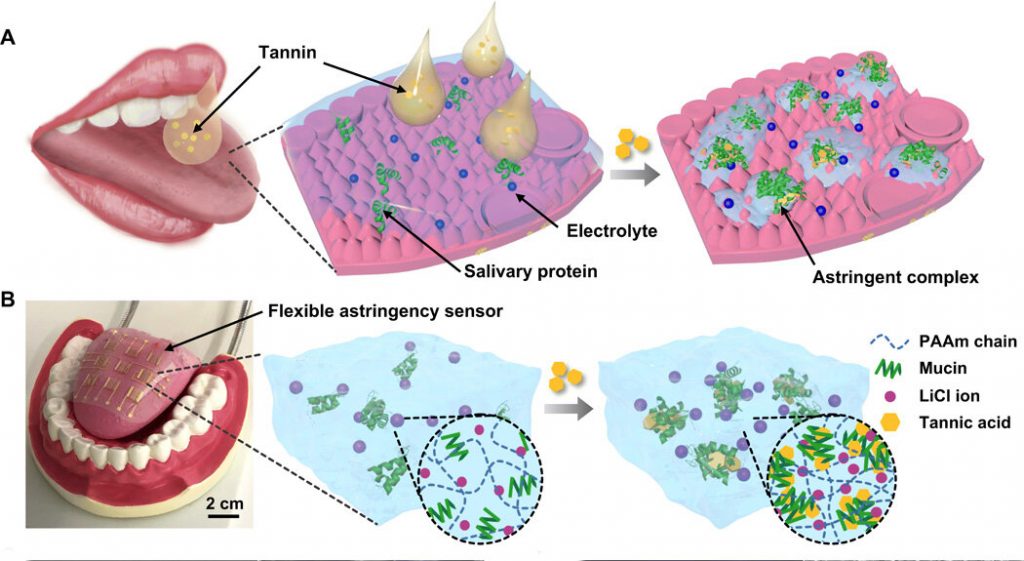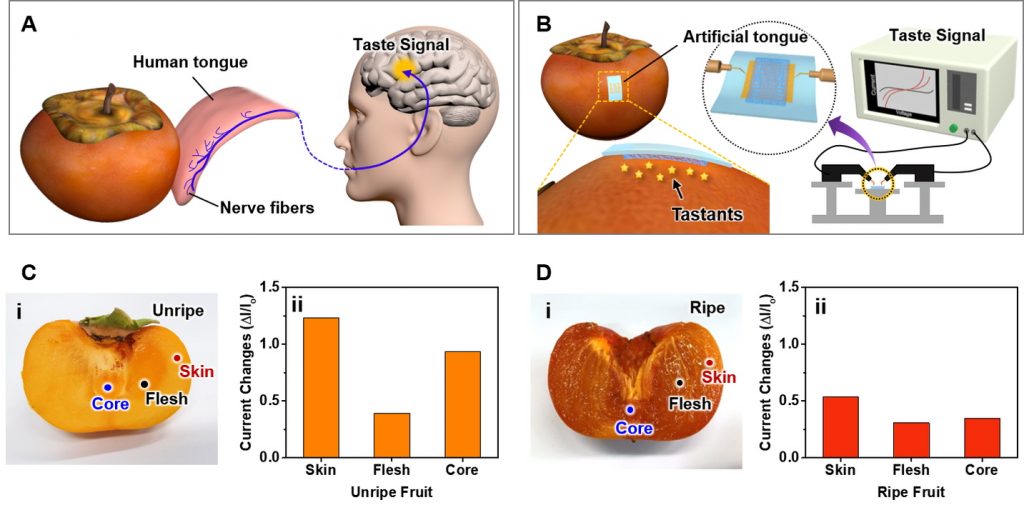Although the judgment of taste is merely subjective, the manufacturing of pharmaceutical and food products require objective taste evaluation. A new artificial tongue that could help generalize the subjective perception of taste has been developed.
A research team, led by Professor Hyunhyub Ko in the School of Energy and Chemical Engineering at UNIST, has created
a soft artificial tongue, using a saliva-like chemiresistive ionic hydrogel anchored to a flexible substrate as a soft artificial tongue
a soft artificial tongue, using a saliva-like, chemiresistive ionic hydrogel anchored to a flexible substrate to create a soft artificial tongue.
an electronic tongue that detects tastes, using microscopic gel with a lot of fine pores.
that mimics the mechanisms of human tongue-like perception of astringency.
measure such objective taste perception has been developed.
capable of measuring objective taste perception
mimicking human tongue-like performance for tastes, such as astringency has been developed.
This electronic tongue, which mimics the principle of human taste detection, can quantitatively express the astringent taste, making it widely applicable in various food, liquor development projects and fruit tree monitoring fields.
Consuming wine or unriped fruits can make your mouth feel bitter. The substance (agglomerated) that is produced when a "taste molecule" such as tannin binds to the mucous membrane protein stimulates (pressure) the mucous membrane, and the human body perceives it as astringent taste. On the other hand, the sweet or salty taste detects the taste of the taste buds in the tongue. Therefore, in order to detect the astringent taste, it is necessary to develop an electronic tongue that operates on a different principle than an electronic tongue that detects already developed sweet taste.

(A) Schematic illustration of astringency sensing principle of the human tongue. (B) Photograph of artificial tongue and schematic illustration of the astringency sensing principle of artificial tongue.
The researchers succeeded in developing an electronic tongue by using an ionic conductive hydration gel, which produces'hydrophobic aggregates' when combined with astringent molecules. It mimics the principle of astringent detection in the mucous membrane of the tongue. This polymer gel contains'mucin' and lithium chloride ions, which serve as the mucous membrane proteins of the tongue, and has many microscopic pores (porous). When mucin binds with astringent molecules, a'hydrophobic aggregate network' is created in the micropores, which can change the conductivity of lithium chloride ions (the degree of ion movement) to detect astringent taste as electrical signals.
"Due to the hydrophobic aggregates, the hydrogel hole wall surface changes from hydrophilic to hydrophobic. At this time, the electrostatic interaction between the microporous wall and the ions flowing therein decreases, improving ion flow and increasing the amount of current flowing through the conductor," says Ayoung Choe (Combined MS/Ph.D program of Energy and Chemical Engineering, UNIST), the co-first author of the study.
The research team conducted an experiment to detect the bitter taste of wine, underripe, and black tea with the developed electronic tongue. As a result of the experiment, it can be confirmed that the electronic tongue quantitatively differentiates the bitterness of various wines such as red, white, and rose wines. In particular, the developed electronic tongue has a wide range of astringency (minimum detection concentration 2×10-6 M~) that can be detected, as well as the degree of astringency upon contact with the sensor.

Applications of the artificial tongue. (A, B) Schematic illustration of wipe-and-detection of the human tongue and artificial tongue. (C, D) Astringency detection of unriped (left) and riped (right) persimmons
"The trained expert can detect the astringency of tens of micromolar (μM) concentrations, while the developed electronic tongue can detect the astringency of 2-3 micromolar concentrations," says Jeonghee Yeom (Combined MS/Ph.D program of Energy and Chemical Engineering, UNIST), the first author of the study.
"We developed a miniature electronic tongue using inexpensive and flexible materials. "It is easy to manufacture and has no complicated specimen preparation process for analysis, so it can be applied to various fields such as food, liquor industry, and agriculture," says Professor Ko.
The findings of this research have been published in Science Advances, a sister journal of Science on June 6, 2020. This study has been supported by 과학기술정보통신부 중견연구자지원사업 지원을 받아 이뤄졌다.
Journal Reference
Jeonghee Yeom, Ayoung Choe, Seongdong Lim, et al., "Soft and ion-conducting hydrogel artificial tongue for astringency perception," Science Advances, (2020).






